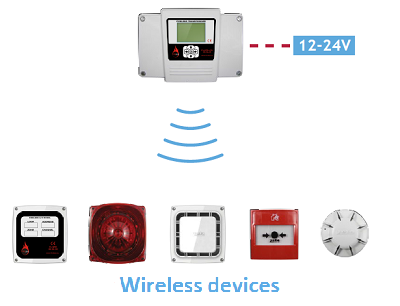COLLECTIVE SYSTEMIn the case of traditional designs, the additional wireless system is adjusted to the existing system. In this configuration, the transponder creates the connection between the wired and the wireless devices. The transponder may be inserted in the conventional zone line without limiting the operation of the other traditional sensors. This line ensures the necessary power supply for the operation of the transponder. In the case of a wireless component alarm, this line is changed to alarm status and the signal is received in the fire detection center. |
|
In addition, the transponder is connected to the siren circuit. If the siren circuit is activated, the transponder activates the wireless sirens, as well. In this case, the transponder does not only transmit, but also records activities so the events can later be identified by title and date on the text display.
INSTALLATION LIMITS
In the case of conventional wired systems, the maximum number of devices to be installed on a single line is 32. One transponder communicates with up to 30 wireless devices. Both restrictions must be complied with, and therefore in the extreme case of having a single transponder on one line only 30 wireless devices can be used.
In the case of a conventional fire alarm system, a transponder can be installed on each line.
One transponder can communicate with a maximum of 30 wireless devices. A maximum of 12 transponders can be used within one RF area. This makes up a total number of 360 devices.
COMPATIBILITY
The transponder is compatible with fire alarm panels with the following specifications:
24VDC nominal input voltage, 1KOhm alarm resistance value
24VDC voltage siren output; reverse polarity when not operating
In addition to the above details, the transponder can be connected to the addressable zone monitor and addressable siren control module. In such cases, the wireless system works as a supplement to the traditional (not addressable) system.
ADDRESSABLE SYSTEMThe system includes an addressable transponder working with the communication protocol of the fire alarm system, which communicates with the wireless devices and the fire detection panel. The transponder communicates with the fire panel: it transmits the status of each wireless device separately, and forwards the control commands from the center to the control devices. The transponder is available with or without text display. The text display version is not absolutely necessary as all events of the wireless device are displayed on the addressable center. |
|
INSTALLATION LIMITS
One transponder can communicate with a maximum of 30 wireless devices. A maximum of 12 transponders can be used within one RF area. This makes up a total number of 360 devices.
COMPATIBILITY
The addressable transponder is compatible with ZETA MKII and APOLLO XP95 protocols.
STAND-ALONE SYSTEMThe transponder can operate as a stand-alone fire detection center. On the front panel, there is a text display and operating buttons. In stand-alone mode, the control modules are activated, the sirens are sounded by the sensors and the manual transmitters. The place of the alarm signal is displayed on the operating panel, where the normal state can be restored. Events memory supports logging. When using the stand-alone mode, it is advisable (but not required) to connect the outlet indicating the alarm state to a remote signal system. |
|
INSTALLATION LIMITS
One transponder can communicate with a maximum of 30 wireless devices.
COMPATIBILITY
In stand-alone mode, the transponder needs 10-30 VDC power supply; 1 potential free contact can be connected to each monitoring device, which means that it is able to cooperate practically with any system.




 INFORMATION
INFORMATION

